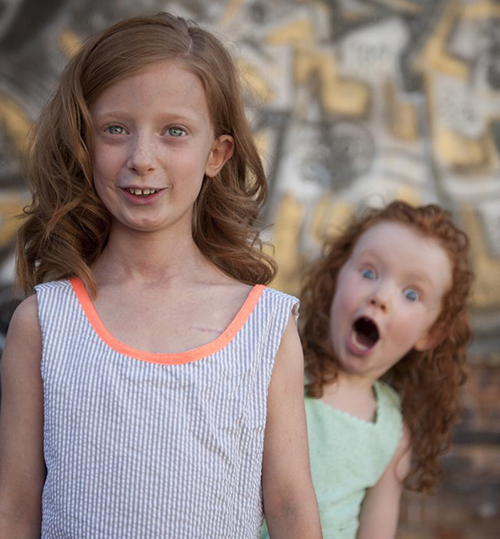|
McCoy Penland: A Source of Strength for Her Family
Thursday, January 15, 2015
By: Christina Relacion
In June 2011, Tara Penland noticed that her daughter McCoy seemed to have less energy and was scratching herself all the time. Three months later, four-year-old McCoy was diagnosed with scleroderma. Today, the 7-year-old second grader is thriving and enjoying playing soccer and the violin. This is McCoy's scleroderma story, as told by her mother, Tara.
|

McCoy Penland, 7, (left) enjoys playing with her little sister Scarlett.
|
McCoy is 7 years old. She was 4 when she was diagnosed with juvenile diffuse systemic scleroderma in 2011.
We had seen a noticeable change in her behavior. She’s been generally a happy and personable kid, and suddenly became very tired and lethargic. We noticed also that she was scratching her torso in her sleep during the night. She would try to find anywhere to scratch, even the walls. Her trunk was the first area to harden. At first, the doctors told us it was eczema, and her trunk was hard because she was constipated.
We ultimately took her to a pediatrician who had just graduated from medical school, and he recognized the symptoms of scleroderma. He put us in contact with Dr. Patrick Knibbe, a rheumatologist in Boise, who had done a fellowship with Dr. Anne Stephens at Seattle Children’s Hospital. From the time McCoy first started to have symptoms to her diagnosis was about three months.
Today, we see Dr. Knibbe in Boise. We also visit Seattle to see Dr. Stephens once or twice each year. McCoy has an interesting case of scleroderma. At this point, she doesn’t have Raynaud’s or internal involvement, mostly because she was diagnosed so quickly. When the symptoms were at their worst, she couldn’t stand up straight, put her hands above her head or make a fist. There was significant scarring on her trunk, back, hands and feet.
Initially, McCoy went through a year of Cytoxan treatments. Then Dr. Stephens read that rituximab had been used successfully on adult patients, so McCoy initially had a dual treatment of Cytoxan chemotherapy followed by Rituximab. The treatment was hard on her system, but after her first round of rituximab, we saw dramatic results. McCoy had two rounds of Rituximab, then another round six months later, and a third round six months after that. She had her last treatment a year ago. We don’t call it “remission,” but her symptoms are not progressing. She’s very active today. She plays soccer, and she’s back to her old self. She and her younger sister Scarlett like to watch Mickey Mouse and play Legos.
McCoy has been such a source of strength for our family. For parents of children with scleroderma, I definitely recommend asking the doctors many questions. We wouldn’t be where we are today without Dr. Knibbe or Dr. Stephens. They have been so willing to answer all our questions. When we left the doctor’s office with challenges and wanted to ease McCoy’s symptoms and pain, they helped us get her back on track to live a life of a little kid.
|
|
|



